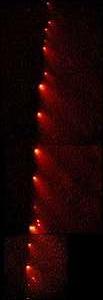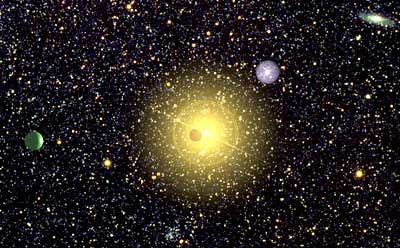
|
Comets
- Some history: Easily visible,
and known since antiquity; Often considered to be signs of important
events, sometimes bad omens and carriers of disease in their
tails; Up to Tycho Brahe, who measured the parallax of one in
1577, they were thought to be atmospheric phenomena.
- Examples: The most famous
one is Halley's comet; It has a very elongated orbit and comes back every 76 years. Shoemaker-Levy 9 broke apart
and smashed into Jupiter in 1994. Several new ones are seen every year by amateurs.
- What are they? Dirty,
dark iceballs from the outer Solar System; The ones
we see from Earth have a several-km wide dark nucleus, which usually
develops a much larger halo ("coma") and one or two tails
of dust and ions, millions of km long (in addition to the trail of icy chunks...), when approaching the Sun. In the outer Solar System
there are thousands bigger than 100 km, and many more
small ones. Size is difficult to determine from Earth, estimates depend
on how much light they reflect.
- Effects on Earth: Direct hits
can be very destructive, but past comet impacts were probably
responsible for bringing to Earth most of the water we see on
it today; What if we pass through a comet's tail?
- Exploration: Very interesting because
of what they tells us about the origin of the Solar System. In addition to flybys, Stardust
collected dust samples from Wild
2 in 2004 and returned them to Earth in 2006; Deep
Impact blasted a hole in Tempel-1 in
2005; ESA's Rosetta, launched in 2004, will meet its comet
in 2014.
- Origin and fate: Those with
periods up to a few hundred years have orbits close to
the ecliptic and come from the Kuiper belt, 30–50 AU from the
Sun, where Pluto and other distant, frozen leftover planetesimals
are located. Comets with
long periods are more icy, have randomly oriented orbits, and
come from the Oort cloud. Each passage
near the Sun makes an ice layer evaporate away (especially the
Sun-grazing ones), and radiation damage can cause them to
become very dark; After 500 or so passes they may fall apart. Others can end up captured by planets.
|


![]()